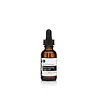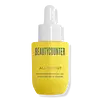What's inside
What's inside
 Key Ingredients
Key Ingredients

 Benefits
Benefits

 Concerns
Concerns

 Ingredients Side-by-side
Ingredients Side-by-side

Simmondsia Chinensis Seed Oil
EmollientVitis Vinifera Seed Oil
EmollientPrunus Armeniaca Kernel Oil
MaskingLimnanthes Alba Seed Oil
Skin ConditioningSclerocarya Birrea Seed Oil
HumectantRosa Canina Seed Oil
EmollientBorago Officinalis Seed Oil
EmollientArgania Spinosa Kernel Oil
EmollientOenothera Biennis Oil
EmollientRubus Fruticosus Seed
Skin ConditioningSambucus Nigra Fruit Extract
AstringentEicosapentaenoic Acid
EmollientActinidia Chinensis Seed Oil
EmollientVaccinium Macrocarpon Seed Oil
Skin ConditioningRubus Occidentalis Seed Oil
EmollientHippophae Rhamnoides Oil
EmollientCalophyllum Inophyllum Seed Oil
AntimicrobialLecithin
EmollientPelargonium Graveolens Oil
MaskingLavandula Angustifolia Flower Oil
MaskingCitrus Aurantium Amara Flower Oil
MaskingRosa Damascena Extract
MaskingTocopherol
AntioxidantBeta-Sitosterol
Emulsion StabilisingHelichrysum Italicum Flower Oil
MaskingRosmarinus Officinalis Extract
AntimicrobialSqualene
EmollientDaucus Carota Sativa Seed Oil
EmollientSolanum Lycopersicum Fruit/Leaf/Stem Extract
AstringentHelianthus Annuus Seed Oil
EmollientAscorbyl Palmitate
AntioxidantLinalool
PerfumingCitronellol
PerfumingGeraniol
PerfumingLimonene
PerfumingCitral
PerfumingEugenol
PerfumingFarnesol
PerfumingSimmondsia Chinensis Seed Oil, Vitis Vinifera Seed Oil, Prunus Armeniaca Kernel Oil, Limnanthes Alba Seed Oil, Sclerocarya Birrea Seed Oil, Rosa Canina Seed Oil, Borago Officinalis Seed Oil, Argania Spinosa Kernel Oil, Oenothera Biennis Oil, Rubus Fruticosus Seed, Sambucus Nigra Fruit Extract, Eicosapentaenoic Acid, Actinidia Chinensis Seed Oil, Vaccinium Macrocarpon Seed Oil, Rubus Occidentalis Seed Oil, Hippophae Rhamnoides Oil, Calophyllum Inophyllum Seed Oil, Lecithin, Pelargonium Graveolens Oil, Lavandula Angustifolia Flower Oil, Citrus Aurantium Amara Flower Oil, Rosa Damascena Extract, Tocopherol, Beta-Sitosterol, Helichrysum Italicum Flower Oil, Rosmarinus Officinalis Extract, Squalene, Daucus Carota Sativa Seed Oil, Solanum Lycopersicum Fruit/Leaf/Stem Extract, Helianthus Annuus Seed Oil, Ascorbyl Palmitate, Linalool, Citronellol, Geraniol, Limonene, Citral, Eugenol, Farnesol
Rosa Canina Seed Oil
EmollientPersea Gratissima Oil
Skin ConditioningVitis Vinifera Seed Oil
EmollientRibes Nigrum Seed Oil
EmollientSclerocarya Birrea Seed Oil
HumectantLimnanthes Alba Seed Oil
Skin ConditioningArgania Spinosa Kernel Oil
EmollientCitrus Nobilis Peel Oil
MaskingCitrus Aurantium Dulcis Peel Oil
MaskingTetrahexyldecyl Ascorbate
AntioxidantCitrullus Lanatus Seed Oil
EmollientRosa Damascena Flower Oil
MaskingHippophae Rhamnoides Fruit Oil
Skin ProtectingGlycine Soja Oil
EmollientTocopherol
AntioxidantPhytosterols
Skin ConditioningLimonene
PerfumingCitral
PerfumingCitronellol
PerfumingLinalool
PerfumingGeraniol
PerfumingRosa Canina Seed Oil, Persea Gratissima Oil, Vitis Vinifera Seed Oil, Ribes Nigrum Seed Oil, Sclerocarya Birrea Seed Oil, Limnanthes Alba Seed Oil, Argania Spinosa Kernel Oil, Citrus Nobilis Peel Oil, Citrus Aurantium Dulcis Peel Oil, Tetrahexyldecyl Ascorbate, Citrullus Lanatus Seed Oil, Rosa Damascena Flower Oil, Hippophae Rhamnoides Fruit Oil, Glycine Soja Oil, Tocopherol, Phytosterols, Limonene, Citral, Citronellol, Linalool, Geraniol
Ingredients Explained
These ingredients are found in both products.
Ingredients higher up in an ingredient list are typically present in a larger amount.
You may know this ingredient as argan oil. Argan Oil has antioxidant, hydrating, and soothing properties.
Studies have shown argan oil can help fight again radical damage from the sun. This makes it effective at preventing hyperpigmentation.
Large amounts of vitamin E found in argan oil helps the skin retain water. Argan oil also contains fatty acids such as linoleic acid, oleic acid, and palmitic acid. It is also a good source of lipids.
Another benefit of argan oil is skin-soothing. It can help reduce inflammation-related skin symptoms.
Argan Oil is effective at regulating sebum production in pores. This can make it effective at treating hormonal acne.
Traditionally, argan oil was used for its antibacterial and antifungal properties. However, argan oil contains fatty acids that may make it not fungal-acne safe.
Argan Trees are native to Morocco.
Learn more about Argania Spinosa Kernel OilCitral is a fragrance and used to add a lemon-like scent to products. It is both naturally found in plants and created synthetically. In plants, it is commonly occurring in lemon myrtle, lemongrass, lemon tea-tree, lemon verbena, and other citruses.
The EU mandates Citral be listed separately as a fragrance. It is a known allergen and may cause contact dermatitis. Citral can also used as a masking ingredient.
The term 'fragrance' is not regulated in many countries. In many cases, it is up to the brand to define this term. For instance, many brands choose to label themselves as "fragrance-free" because they are not using synthetic fragrances. However, their products may still contain ingredients such as essential oils that are considered a fragrance.
The term 'citral' is a collective term for two geometric isomers: geranial/Citral A and neral/Citral B.
Learn more about CitralCitronellol is used to add fragrance/parfum to a product. It is often derived from plants such as roses. In fact, it can be found in many essential oils including geranium, lavender, neroli, and more. The scent of Citronellol is often described as "fresh, grassy, and citrus-like".
Since the Citronellol molecule is already unstable, Citronellol becomes irritating on the skin when exposed to air.
Citronellol is a modified terpene. Terpenes are unsaturated hydrocarbons found in plants. They make up the primary part of essential oils.
Citronellol is not able to be absorbed into deeper layers of the skin. It has low permeability,
Citronellol is also a natural insect repellent.
Learn more about CitronellolGeraniol is used to add fragrance/parfum to a product. It is the main component of citronellol. It is a monoterpenoid and an alcohol.
Monoterpenes are naturally found in many parts of different plants.
Geraniol can be found in many essential oils including Rose Oil and Citronella Oil. The scent of Geraniol is often described as "rose-like". Many foods also contain Geraniol for fruit flavoring.
Geraniol can irritate the skin when exposed to air. However, irritation depends on the ability of geraniol to penetrate into the skin. In general, geraniol is not able to penetrate skin easily.
Geraniol is colorless and has low water-solubility. However, it is soluble in common organic solvents.
Like citronellol, it is a natural insect repellent.
2,6-Octadien-1-ol, 3,7-dimethyl-, (2E)-
Learn more about GeraniolLimnanthes Alba Seed Oil is the oil extracted from the seeds of the meadowfoam plant. This oil is non-fragrant and is an emollient. As an emollient, meadowfoam seed oil helps soften and hydrate the skin.
Meadowfoam seed oil is stable and has a long shelf life due to its chemical structure. It has the highest concentration of stable fatty-acids among plant oils, preventing it from degrading once exposed to oxygen.
Due to the fatty acid content, this ingredient may not be fungal-acne safe.
Meadowfoam is native to California and Oregon.
Learn more about Limnanthes Alba Seed OilLimonene is a fragrance that adds scent and taste to a formulation.
It's found in the peel oil of citrus fruits and other plants such as lavender and eucalyptus. The scent of limonene is generally described as "sweet citrus".
Limonene acts as an antioxidant, meaning it helps neutralize free radicals.
When exposed to air, oxidized limonene may sensitize the skin. Because of this, limonene is often avoided by people with sensitive skin.
The term 'fragrance' is not regulated in many countries. In many cases, it is up to the brand to define this term. For instance, many brands choose to label themselves as "fragrance-free" because they are not using synthetic fragrances. However, their products may still contain ingredients such as essential oils that are considered a fragrance.
Learn more about LimoneneLinalool is a fragrance and helps add scent to products. It's derived from common plants such as cinnamon, mint, citrus, and lavender.
Like Limonene, this ingredient oxidizes when exposed to air. Oxidized linalool can cause allergies and skin sensitivity.
This ingredient has a scent that is floral, spicy tropical, and citrus-like.
Learn more about LinaloolRosa Canina Seed Oil comes from the seeds of the dog-rose plant. It is an emollient.
Emollients help hydrate your skin by trapping moisture in. They create a thin film on the skin to prevent moisture from escaping.
Rosa Canina Seed Oil contains phenolic compounds, carotenoids, Vitamin C, linoleic acid, and other fatty acids.
Due to the fatty acid content, this ingredient may not be fungal-acne safe.
Learn more about Rosa Canina Seed OilSclerocarya Birrea Seed Oil is the oil expressed from the seeds of the Marula plant. In South Africa, Marula is called "an elephant's favorite treat".
Marula seed oil is a non-fragrant oil. It is rich in fatty acids, such as oleic, linoleic, palmitic, stearic, and more. These fatty acids help hydrate the skin.
Other components of marula seed oil include vitamin E and antioxidants such as flavonoids.
Due to the fatty acid content, this ingredient may not be fungal-acne safe.
Learn more about Sclerocarya Birrea Seed OilTocopherol (also known as Vitamin E) is a common antioxidant used to help protect the skin from free-radicals and strengthen the skin barrier. It's also fat soluble - this means our skin is great at absorbing it.
Vitamin E also helps keep your natural skin lipids healthy. Your lipid skin barrier naturally consists of lipids, ceramides, and fatty acids. Vitamin E offers extra protection for your skin’s lipid barrier, keeping your skin healthy and nourished.
Another benefit is a bit of UV protection. Vitamin E helps reduce the damage caused by UVB rays. (It should not replace your sunscreen). Combining it with Vitamin C can decrease sunburned cells and hyperpigmentation after UV exposure.
You might have noticed Vitamin E + C often paired together. This is because it is great at stabilizing Vitamin C. Using the two together helps increase the effectiveness of both ingredients.
There are often claims that Vitamin E can reduce/prevent scarring, but these claims haven't been confirmed by scientific research.
Learn more about TocopherolVitis Vinifera Seed Oil comes from the grape vine. Grape seeds are a byproduct of creating grape juice or wine.
The components of grape seeds have many skin benefits. Research has found it to be antimicrobial and anti-inflammatory. It also contains many potent antioxidants such as Vitamin E , Vitamin C, proanthocyanidins, polyphenols, flavonoids, and anthocyanins. Proanthocyanidin has been shown to help even out skin tone.
Antioxidants help fight free-radical molecules. Free-radical molecules are capable of damaging our cells and other genetic material. Antioxidants help stabilize free-radicals by donating extra electrons. Grape seed extract may help reduce the signs of aging.
The antimicrobial properties of grape seed may help treat acne. However, more research is needed to support this claim.
Grape seed has also been found to help absorb UV rays. Grape seed extract should not replace your sunscreen.
The fatty acids of grape seed oil give it emollient properties. Emollients help soothe and soften your skin by creating a film. This film traps moisture within, keeping your skin hydrated.
Learn more about Vitis Vinifera Seed Oil